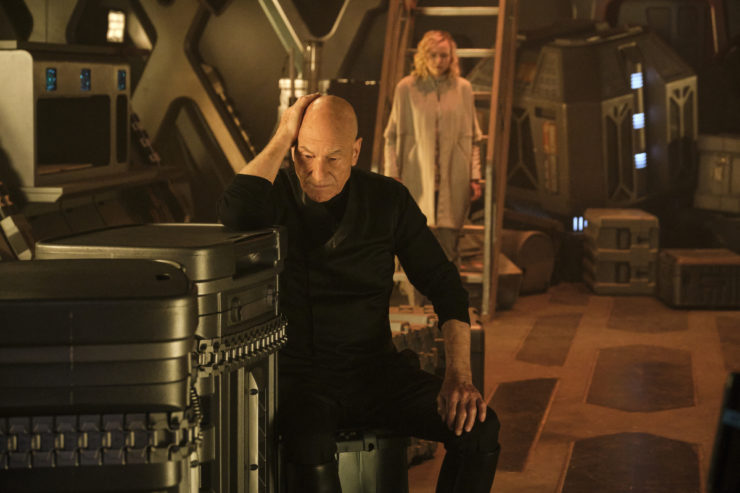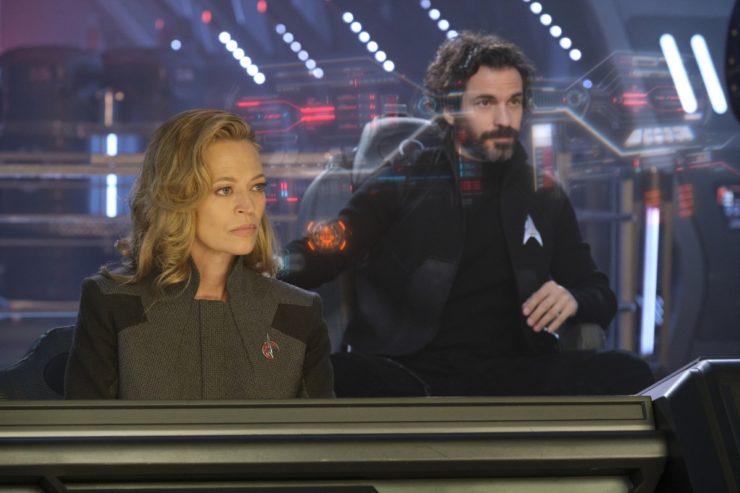Time travel is a well that the various Star Treks have dipped into way more often than probably even makes sense. From “Tomorrow is Yesterday” and “The City on the Edge of Forever” in the first season of the original series through every single spinoff and a couple of the movies, all the way to Discovery (which has had several bits of time travel between the twenty–third and thirty–second centuries) and Prodigy (the delightful “Time Amok”).
And now Picard has joined the crowd, by dumping most of its main characters into Los Angeles a mere two years in the future. Kind of.
The Los Angeles we see sorta-kinda looks like the world outside our door. There’s a depressing number of homeless people, Immigration and Customs Enforcement officers are acting like fascist shock troops going after immigrants with darker skin, and heterosexual male security guards will fall for anything said to them by pretty women, especially if they’re a couple.
But it also doesn’t in one interesting way: there’s a forthcoming mission to Europa that is a big enough deal to have billboards and stuff.
So what we’re seeing here is a mix of the actual early twenty-first century mixed in with what older iterations of Trek thought the early twenty-first century would be like, to wit, one filled with space travel and other science fictional stuff (the Botany Bay from “Space Seed,” Shaun Christopher’s mission to Saturn from “Tomorrow is Yesterday,” the cryogenically frozen folks from “The Neutral Zone,” etc.).
In order to get there, our heroes first must defeat the magistrate and his minions. The opening scene is actually pretty intense, with Seven trying to bluff her way into ordering her husband to stand down, and her husband not buying it. The magistrate has figured out that our heroes are imposters of some sort, and proves it by the simple expedient of asking “President Hansen” to tell him what his full name is.
Unfortunately for the magistrate (whose full name we never do find out), he let Seven get too close. One thing I’m heartened to see more often in dramatic fiction is the understanding that, if you’re trained, you can disarm someone holding a pistol-type weapon if you get close enough to them. Seven is trained (probably more so than the real President Hansen is), and she disarms the magistrate, which surprises everyone enough that Seven and Musiker make short work of the bad guys, killing all three of them.
However, Elnor, who got shot last week, dies on the table despite Musiker’s heroic efforts to save him in La Sirena’s apparently hologram-free sickbay. Elnor’s death has much more of an impact on Musiker—who has been mentoring him at the Academy, and got him assigned to the Excelsior so she could keep an eye on him—than it does, honestly, on the viewer. Elnor hasn’t really been much of a character, and if you removed him entirely from the first season of Picard, absolutely nothing of consequence would have changed. Apparently, it’s even harder to justify his existence in season two, because they’ve summarily executed him after he’s done very little beyond one scene of kickassery in “Penance.”

La Sirena comes under fire by Confederation forces, but the Borg Queen is able to hook herself up to the ship and take the enemy vessels out, then provide the right calculations and navigation for La Sirena to pull the same trick that the Enterprise pioneered in the aforementioned “Tomorrow is Yesterday” to get home from 1969, and also used in “Assignment: Earth” and The Voyage Home to go back and forth in time.
I do like that director Lea Thompson is inspired by the surreal imagery used in The Voyage Home when they went back in time, but doesn’t copy it exactly (as it was actually kind of doofy looking). It’s a nice little homage that improves on what Leonard Nimoy did in that 1986 film.
Once they arrive and crash land in a forest somewhere (the episode doesn’t really make it all that clear where Picard lands the ship), they find that the Borg Queen is unconscious, most of the ship’s systems are down, and they have no idea where to find the Watcher that the queen says they need to find.
They manage to get the transporter working decently enough, and they beam Rios, Seven, and Musiker into L.A. proper to go to the highest point in the city to scan for technology that’s out of place in early-twenty-first-century America. Meantime, Picard and Jurati are going to try to revive the queen enough to get more information out of her. Jurati risks assimilation by plugging herself into the queen to charge her up enough to get her going again—Picard can’t do it, because he was already assimilated once, and she’ll take him over easily—and she manages to extract the location of the Watcher, to the queen’s chagrin.
Buy the Book


Until the Last of Me
The transporters are unable to be very precise. Musiker winds up in a homeless encampment and almost gets mugged, Seven arrives close enough to get to her on foot, but Rios arrives several feet off the ground and falls to the sidewalk, sustaining a nasty head injury.
Because he’s Latinx and has no papers, the person who finds Rios brings him to a clinic that treats undocumented people and others who can’t afford a hospital—either financially or reputationally. He has a concussion and a dislocated hand, which is treated.
The banter between Rios and the doctor who runs the clinic (and her kid) is one of the two best parts of the episode. And it, of course, leads to disaster, as ICE shows up to do a raid. Rios tries to help out, but gets himself arrested for his trouble.
That’s how the episode ends. Musiker was unwilling to wait for the queen to wake up to find the Watcher, and because of that, Rios got himself injured and put in the system, something they absolutely could not afford to do, as that risks polluting the timelines even more. Rios did try his best, but he couldn’t just not help out a person in need, either.
The other best part is Jurati’s being almost assimilated. Allison Pill is magnificent as always, transitioning from Jurati to Jurati’s subconscious to an assimilated Borg and back again with impressive verve. It’s a scary scene, as we are concerned every moment that Jurati will be assimilated. One thing that Elnor’s death in the episode accomplishes is make the cast vulnerable. If Elnor can die, then maybe Jurati can be assimilated.
However, the rest of the episode is less than engaging. For starters, all the discussion about the Borg Queen and assimilation and the risks Jurati is taking is bizarrely missing Seven of Nine. The former Tertiary Adjunct of Unimatrix 01 should, it seems me, have Things To Say about the use of the Borg Queen. Instead, she’s reduced to the role of Musiker’s girlfriend, trying to help her get through the death of Elnor and make sure she doesn’t do anything crazy.
They then get to play dress-up in the past, Musiker taking down the homeless mugger and both of them fooling a guard into letting them stay up on a restricted rooftop. Seven channels a different Jeri Ryan character in this scene, Tara Cole, the grifter she played in several episodes of Leverage. She expertly plays the guard, getting him to tell the name of a colleague so she can say he gave her permission to do the same thing in the past.
As fun as that is, the whole thing has a perfunctory, been-there-done-that feel. We’ve seen our heroes play around in the past like this so many times before (besides the episodes I’ve already mentioned, there’s TNG’s “Time’s Arrow,” DS9’s “Past Tense,” Voyager’s “Future’s End,” etc.), and this adds nothing new to it. To make matters worse, Seven, Musiker, and Rios don’t actually accomplish anything, as the answers come from Jurati’s brain-dive into the Borg Queen (extracting the information and storing it on La Sirena’s computer under “shit I stole from the Borg Queen”).
I will say that, as good as Pill is going up against the Borg Queen (as is Annie Wersching as the queen), as good as Ryan is at Seven owning the past, as good as Santiago Cabrera is in Rios’ scenes in the clinic, this episode is owned by Michelle Hurd, who absolutely nails Musiker’s anguish at Elnor’s death, her righteous indignation at the entire situation, and her barely controlled anger. The best is when she confronts Picard about how this all came about because of Picard and Q playing around—and while Picard rightly insists that Q is the one who’s playing and Picard is merely dragged along for the ride, Musiker’s view of it is not unreasonable on the face of it. Q’s ongoing dance with Picard has had nasty consequence more than once—most notably the eighteen people who died when he forcibly introduced the Enterprise to the Borg—and one can’t entirely blame anyone for believing Picard is at least partly responsible for it. (Q himself is only in one brief scene, showing up long enough to confuse and annoy Picard and not be seen by anyone else, which really feels like it’s there to justify being able to say that John deLancie guest-starred in this one, too.)
The one actor who’s surprisingly subdued in this one is Sir Patrick Stewart. After so beautifully playing Picard’s late-life crisis in “The Star Gazer” and both his fury at Q and his cosplaying as a fascist in “Penance,” he barely seems to have shown up for “Assimilation.” Still, even subdued Stewart is better than most people’s regular energy, and in general, whatever drawbacks the script has are mitigated greatly by everyone’s excellent acting and Thompson’s superb direction.
I just hope we actually meet the Watcher next week. We’re three episodes in and we keep resetting the plot. Some forward movement would be nice.
Keith R.A. DeCandido has written the character of Jean-Luc Picard in his Star Trek fiction several times, including in the novels Diplomatic Implausibility, The Brave and the Bold Book 2, Q & A, and A Time for War, a Time for Peace; the novellas A Gutted World (in Myriad Universes: Echoes and Refractions) and Enterprises of Great Pitches and Moment (part of the Slings and Arrows miniseries); the comic book Perchance to Dream; and the short story “Four Lights” in The Sky’s the Limit, which was narrated by Picard in the first person.










